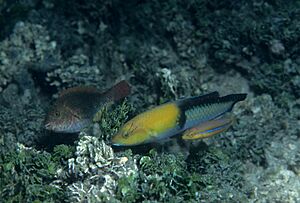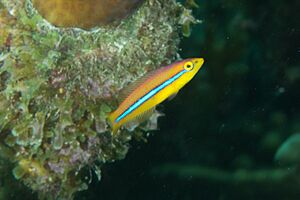Yellowhead wrasse facts for kids
Quick facts for kids Yellowhead wrasse |
|
|---|---|
 |
|
| Mature male and juvenile | |
| Conservation status | |
| Scientific classification | |
| Synonyms | |
|
The yellowhead wrasse (Halichoeres garnoti) is a colorful fish that lives in the warm, shallow waters of the Caribbean Sea and the western Atlantic Ocean. It belongs to the wrasse family, which is a large group of fish known for their bright colors and interesting behaviors.
Contents
Meet the Yellowhead Wrasse
The yellowhead wrasse is a small fish. It can grow up to about 19 centimeters (7.5 inches) long. What's really cool about this fish is that its looks change a lot throughout its life! Its colors and patterns are different depending on its age and whether it's a male or a female.
How It Looks at Different Ages
The yellowhead wrasse has a thin, long body. Its mouth is at the very front of its head.
- Young Fish (Juvenile): When it's young, the yellowhead wrasse is mostly yellow. It has a bright blue stripe running along its side.
- Female Fish (Initial Phase): As it grows into a female, its back becomes dark, sometimes with blue hints. Its belly stays yellow. You might also see two short, wavy dark lines near its eyes. There are also dark spots on the front of its head.
- Male Fish (Adult): When it becomes an adult male, its head and the front part of its body turn yellow. The back half of its body is silvery-grey. It has a black-blue bar and a wide black-blue stripe along its top fin. From this dark blue line, you can see three lines of different colors: green, blue, and then pink or purple. The blue line continues along the fish's belly. Adult males still have those wavy dark lines and black spots near their eyes.
Where Yellowhead Wrasses Live
The yellowhead wrasse is found in many tropical and subtropical areas. These include the western Atlantic Ocean, the Caribbean Sea, and the Gulf of Mexico. You can find them as far south as the northern coast of Venezuela.
Their Home in the Ocean
These fish are common around coral reefs, sandy areas, and rocky spots. They usually live in water that is up to about 60 meters (200 feet) deep. They love places with lots of small holes and cracks. These spots are perfect for hiding if danger is near!
What Yellowhead Wrasses Eat
The yellowhead wrasse is a predator. This means it hunts and eats other small creatures. It mostly eats tiny invertebrates. These include crustaceans (like small crabs), molluscs (like snails), worms, and echinoderms (like sea urchins). They find their food on the ocean floor or in the sand. Their strong teeth help them grab crustaceans and pull prey off rocks.
Cleaning Up the Reef
When they are young, yellowhead wrasses sometimes act like "cleaner fish". This means they will pick tiny parasites off bigger fish. It's like a cleaning service for other ocean animals!
Life Cycle and Reproduction
Like many other wrasses, the yellowhead wrasse is a special kind of hermaphrodite. This means they start their lives as females and later change into males. This sex change usually happens when they are about 7 centimeters (2.7 inches) long.
Family Life
During the time they reproduce, adult male yellowhead wrasses become very protective of their space. They gather in special areas called leks to attract females. Each day, they swim from their feeding areas to these special breeding spots. The biggest males often get to mate with the most females.
Status and Conservation
The yellowhead wrasse is sometimes caught for the aquarium trade. However, this is not a big threat to their overall numbers. This species is listed as "Least Concern" (LC) on the UICN Red List. This means that scientists believe there are plenty of them in the wild, and they are not currently at risk of disappearing.
Images for kids




